A Set of Homemade Weighing Scales
Simple balances you can make with cheap, everyday household supplies
You can buy a classroom set of weighing scales pretty cheaply, but in my experience they tend to be pretty insensitive and useless. Instead of buying a set, you can build a simple set of your own — one that is delicate enough to detect the weight of a cottonball, or to detect the difference between a pure copper penny (pre-1982) and a copper-coated zinc penny (post 1982).
Simple No-Tools Version
For a simple balance that requires no tools to build, poke holes in two paper cups and tie strings to them to make two buckets, then hang them from opposite ends of a 10-gallon paint stick. (Hardware stores sometimes give paint sticks away. If you tell them you're a teacher, they might even give you a bunch.) You will probably want to tape the strings to the ends of the stick to keep them from falling off when the beam tilts. Next, attach a binder clip to the middle of the stick, dangle it from your fingertips, and work the clip back and forth on the stick until the stick hangs level. Now hang the binder clip from a pen or pencil or something, and you're done.
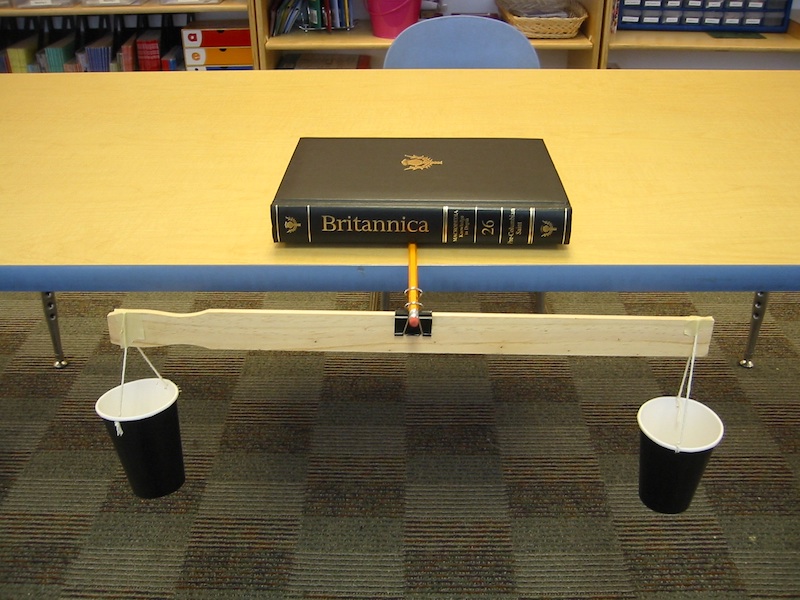
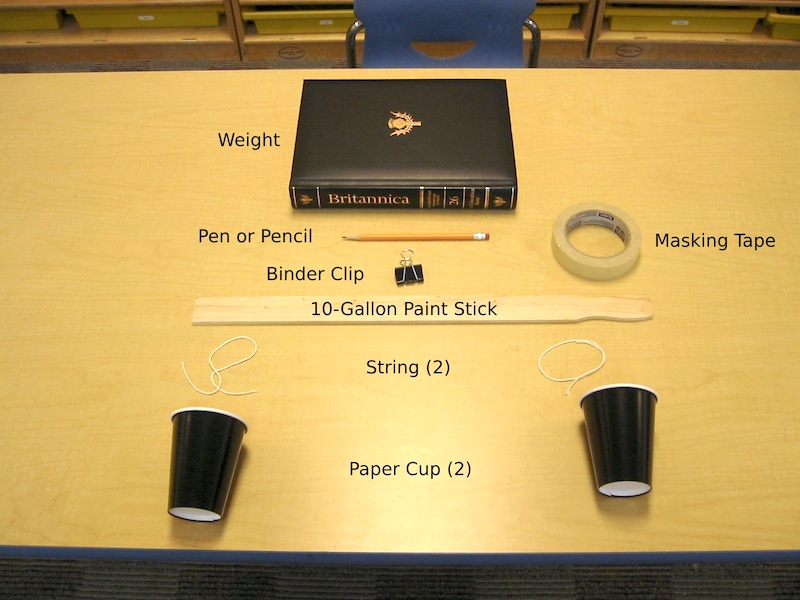
For the suspension pin, you could also use a knitting needle or bamboo skewer, or as long as you are at the hardware store to pick up the paint stick, you could also buy a short wooden dowel. If you are going to use your scales in a home garage, you could also hang it from it a nail driven into a wall stud.
Alternate Versions
The simple version can be cleaned up and made a little nicer in a couple of ways. First, to make a more symmetric and less amateurish-looking beam, you can saw the handle end off of the paint stick to make a neat rectangle. The paper cups are also a little too tall and too opaque to be convenient. Shorter and broader plastic cups — the kind you drink punch from at parties — make better scales, although the common kind are brittle polystyrene and keep cracking. (These will say “PS” on the bottom.) If you can find softer, more flexible polypropylene (“PP”) or polyethylene-terephthalate (“PETE”) cups, these will make wonderful scale pans. You can easily make holes for the string by heating the end of a straightened paperclip in a flame and then pressing it through the plastic. In the picture below, I have also replaced the pencil with a nice wooden dowel, and the bland cotton string with colorful nylon “mason's line” from the hardware store. The nylon string tends to unravel quickly at the ends, but you can easily melt the ends into a permanent knot with a small flame.
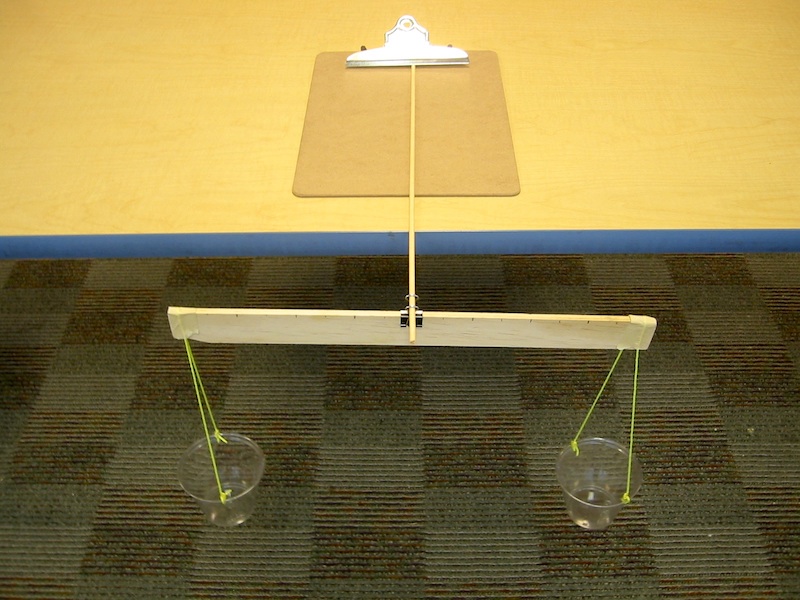
As I said, these versions are sensitive enough to detect the weight of a cottonball. But if you want an even more sensitive version, you could use a longer beam — say, a yardstick.
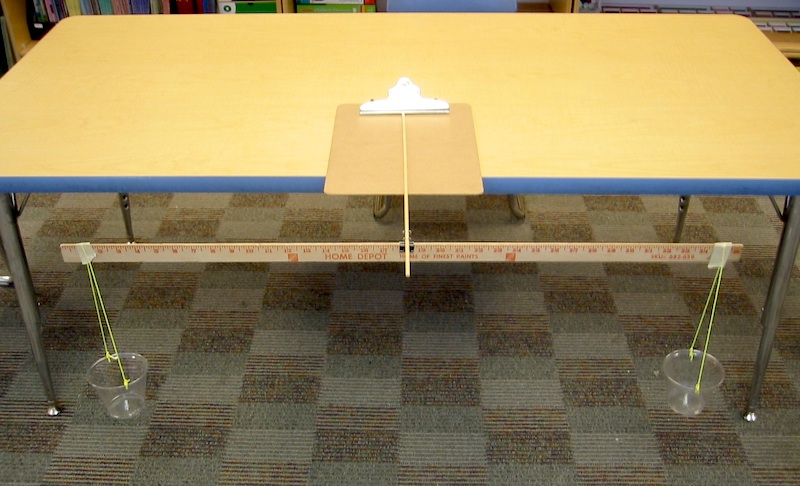
I happen to have stands from balance beams that I ordered from a commercial company. The beams and cups were clumsy and ineffective, but the stands were ok, although they tended to tip over easily. So I used their stands to hold up my beams. I drilled a small hole in the tops of my beams, and then suspended them from the pin in the commercial stands. At some point, I may come up with a design for a homemade stand, but that will require some carpentry skills to build, and if you have some carpentry skills, you can probably design your own stand.
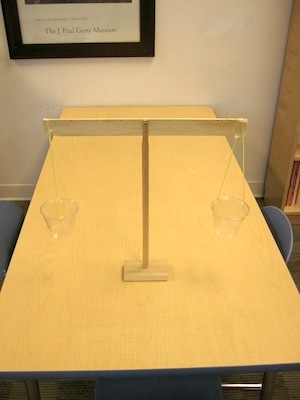
Weight-Counting Activities
Small children seem to love piling anything and everything into the cups to try to make them balance. In a sense, they have discovered the foundations of weight measurement. All physical measurement starts by noticing that one thing is “more” or “less” than another in some way, and finding a way to compare them. This object is longer, or larger, or heavier, or hotter, or brighter than that object. And if you can find a way to compare two objects and find out whether one is greater than, equal to, or less than another, you have discovered the foundation for a physical measurement of that quality. The balance beam is the foundation of weight measurement. For a more refined comparison activity, try having formal “weight-wars” by putting two similar objects in the cups and seeing which one wins. This works especially well when neither object is obviously heavier than the other — like a cottonball and a paperclip. (A cottonball can be heavier than a paperclip, which is pretty impressive to children.)
For an activity with older kids, try weighing things by counting seeds. If you have popcorn or dry rice or dry beans or something around the house, see how many it takes to balance an interesting object, and then you can express the weight of the object in grains. By counting how many grains the object is equivalent to, you can express “how heavy” as a number, i.e. you can measure the weight of the object — in grains. (The modern unit of “grain”, which is sometimes used to measure ammunition, is based on the weight of a wheat seed, which was once commonly used as a weight-counting unit. The modern unit of “carat” that we use to measure the weights of precious stones, derives from the weight of a carob seed.)
If you have metric containers for measuring milliliters of water, you can also use your balance to measure the weight of interesting objects in grams. One gram is defined to be the weight of one milliliter of water, so if you can balance your object against water in the other cup, and you can measure the amount of water in milliliters, that number will also be the weight of the water in grams, and thus also the weight of the balanced object in grams.